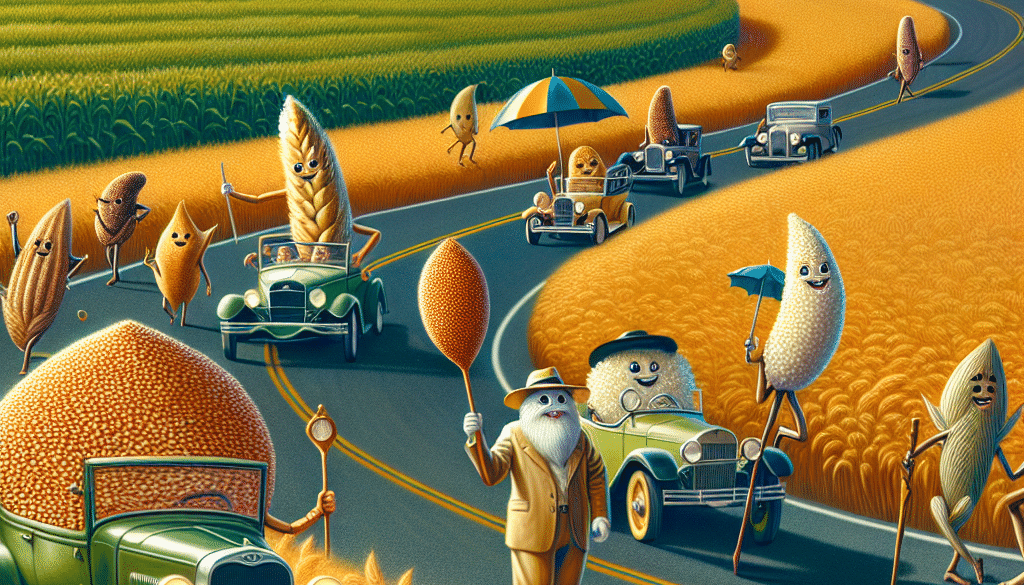The Return of Ancient Grains
-
Table of Contents
- Ancient Grains Make a Modern Comeback: Nutritional and Culinary Revival
- The Rise of Ancient Grains in Modern Diets
- Nutritional Benefits of Ancient Grains
- Incorporating Ancient Grains into Modern Meals
- Case Studies and Statistics: The Growth of Ancient Grains
- Challenges and Considerations
- Conclusion: Embracing the Ancient Grain Trend
- Discover ETprotein’s Range of Protein Products
Ancient Grains Make a Modern Comeback: Nutritional and Culinary Revival

In recent years, there has been a significant resurgence in the popularity of ancient grains. These grains, which have been cultivated for thousands of years, are making a comeback in modern diets due to their nutritional benefits, sustainability, and unique flavors. This article explores the reasons behind the return of ancient grains, their health benefits, and how they are being incorporated into contemporary cuisine.
The Rise of Ancient Grains in Modern Diets
The term “ancient grains” refers to a group of grains and cereals that have remained largely unchanged over the last several centuries. Unlike more common grains like wheat, corn, and rice, which have been extensively bred and modified, ancient grains have been preserved through traditional agricultural practices.
Some of the most popular ancient grains include:
- Quinoa
- Amaranth
- Millet
- Spelt
- Farro
- Freekeh
- Chia
- Teff
- Sorghum
- Kamut
Their resurgence can be attributed to several factors:
- Health Consciousness: As consumers become more health-conscious, they seek out nutrient-dense foods that offer more than just calories.
- Gluten Sensitivity: With the rise of gluten intolerance and celiac disease, many people are looking for gluten-free alternatives to traditional wheat-based products.
- Sustainability: Ancient grains often require less water and can be grown in harsher climates, making them a more sustainable choice in the face of climate change.
- Culinary Diversity: Chefs and home cooks are exploring ancient grains for their unique flavors and textures, which add diversity to meals.
Nutritional Benefits of Ancient Grains
Ancient grains are not only versatile in the kitchen but also offer a myriad of health benefits. They are typically high in fiber, protein, vitamins, and minerals. For example, quinoa is known for its complete protein profile, containing all nine essential amino acids. Teff, despite its tiny size, is packed with calcium, iron, and vitamin C. Additionally, many ancient grains have a low glycemic index, which can help manage blood sugar levels.
Here are some specific nutritional highlights of popular ancient grains:
- Quinoa: High in protein, fiber, magnesium, B vitamins, iron, potassium, calcium, phosphorus, vitamin E, and various beneficial antioxidants.
- Amaranth: Rich in fiber, protein, micronutrients, and lysine, an essential amino acid.
- Millet: Gluten-free and provides phosphorus, magnesium, and antioxidants.
- Chia: Loaded with omega-3 fatty acids, fiber, antioxidants, iron, and calcium.
Incorporating Ancient Grains into Modern Meals
Chefs and food enthusiasts are finding innovative ways to include ancient grains in everyday meals. From breakfast bowls featuring amaranth or teff to salads tossed with farro or freekeh, these grains are becoming a staple in health-conscious households. They can also be found in a variety of products such as bread, pasta, crackers, and even beverages.
Here are some creative ways to incorporate ancient grains into your diet:
- Use quinoa or millet as a base for a hearty and nutritious salad.
- Substitute traditional rice with farro or freekeh for a nuttier flavor and chewier texture.
- Make a warm breakfast cereal with amaranth or teff, topped with fresh fruit and nuts.
- Bake with spelt or kamut flour for a richer, more wholesome taste in bread and pastries.
Case Studies and Statistics: The Growth of Ancient Grains
Market research indicates a growing demand for ancient grains. According to a report by MarketsandMarkets, the global ancient grain market is projected to reach USD 4.8 billion by 2025, growing at a CAGR of 5.8% from 2020 to 2025. This growth is driven by increasing health awareness and consumer demand for non-GMO and organic food products.
One notable case study is the quinoa boom in Bolivia and Peru, where the grain’s popularity led to significant economic growth. However, it also raised concerns about sustainability and the impact on local communities. This has prompted a movement towards more responsible sourcing and production practices.
Challenges and Considerations
While the return of ancient grains is largely positive, there are challenges to consider. The popularity of these grains can sometimes lead to over-commercialization, which may threaten traditional farming practices and biodiversity. Additionally, as demand increases, it’s important to ensure that the benefits are shared fairly with the farmers and communities who have preserved these grains for generations.
Conclusion: Embracing the Ancient Grain Trend
The return of ancient grains offers an exciting opportunity to diversify our diets, support sustainable agriculture, and rediscover the rich culinary heritage of our ancestors. By choosing ancient grains, consumers can enjoy a range of health benefits while contributing to a more sustainable and equitable food system.
Discover ETprotein’s Range of Protein Products
If you’re looking to incorporate high-quality protein into your diet alongside ancient grains, ETprotein offers a variety of organic bulk vegan proteins that are non-GMO and allergen-free. Their products include organic rice protein, pea protein, and a range of seed proteins, all characterized by a neutral taste and high purity levels. ETprotein’s offerings cater to various industries and are ideal for those seeking comprehensive protein solutions.
About ETprotein:
ETprotein, a reputable protein and L-(+)-Ergothioneine (EGT) Chinese factory manufacturer and supplier, is renowned for producing, stocking, exporting, and delivering the highest quality organic bulk vegan proteins and L-(+)-Ergothioneine. They include Organic rice protein, clear rice protein, pea protein, clear pea protein, watermelon seed protein, pumpkin seed protein, sunflower seed protein, mung bean protein, peanut protein, and L-(+)-Ergothioneine EGT Pharmaceutical grade, L-(+)-Ergothioneine EGT food grade, L-(+)-Ergothioneine EGT cosmetic grade, L-(+)-Ergothioneine EGT reference grade and L-(+)-Ergothioneine EGT standard. Their offerings, characterized by a neutral taste, non-GMO, allergen-free attributes, with L-(+)-Ergothioneine purity over 98%, 99%, cater to a diverse range of industries. They serve nutraceutical, pharmaceutical, cosmeceutical, veterinary, as well as food and beverage finished product distributors, traders, and manufacturers across Europe, USA, Canada, Australia, Thailand, Japan, Korea, Brazil, and Chile, among others.
ETprotein specialization includes exporting and delivering tailor-made protein powder and finished nutritional supplements. Their extensive product range covers sectors like Food and Beverage, Sports Nutrition, Weight Management, Dietary Supplements, Health and Wellness Products, and Infant Formula, ensuring comprehensive solutions to meet all your protein needs.
As a trusted company by leading global food and beverage brands and Fortune 500 companies, ETprotein reinforces China’s reputation in the global arena. For more information or to sample their products, please contact them and email sales(at)ETprotein.com today.












